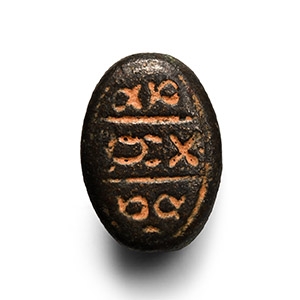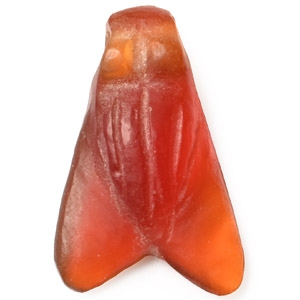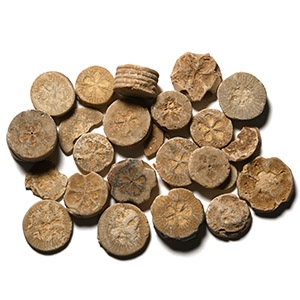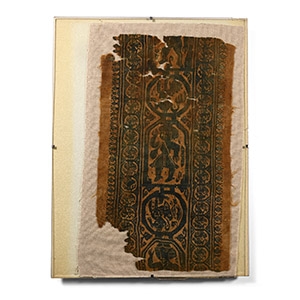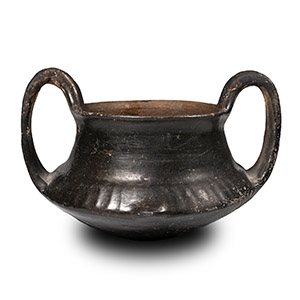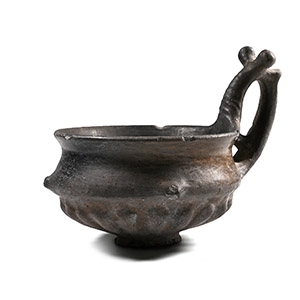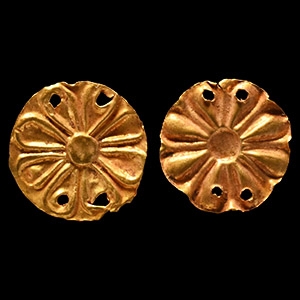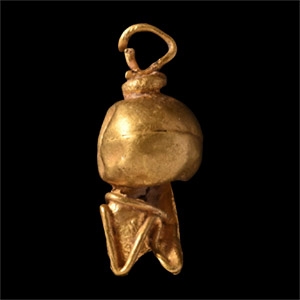Home > Auctions > 3 - 11 June 2025
Ancient Art, Antiquities, Books, Natural History & Coins
From the property of a London, UK, gentleman, 1970-2000s.
This lot is accompanied by an illustrated lot declaration signed by the Head of the Antiquities Department, Dr Raffaele D'Amato.
Cf. Andrews, C., Amulets of Ancient Egypt, London, 1994, p. 53 fig. 54d, for a similar duck scaraboid; Matouk, F.S., Corpus du scarabée égyptien. Vol. 2: Analyse thématique, Beirut, 1976, p. 388, nos. 814-815, for similar-themed scarabs.
Baboons were observed worshipping the rising sun with raised arms, a behaviour that Egyptians interpreted as divine reverence. The scarab's imagery symbolises cosmic harmony and sacred wisdom, with the baboon (a manifestation of Thoth in his lunar aspect) showing reverence to an obelisk (a symbol of the solar god, Ra). Thus, it blends moon and sun symbolism, embodying balance, cyclical renewal, divine order, and the interplay between knowledge (Thoth) and power (Ra). The neb sign indicates lordship or possession over all the celestial forces.
Ex London and Home Counties collection, UK, 1920-1940.
This lot is accompanied by an illustrated lot declaration signed by the Head of the Antiquities Department, Dr Raffaele D'Amato.
Cf. Andrews, C., Amulets of Ancient Egypt, London, 1994, p.62.
Fly amulets are first attested during the Predynastic period (pre 3,100 BC). It is possible that they represented a wish to emulate the fly's renowned fecundity. These amulets were made in a variety of materials, including gold, and golden flies were used in the New Kingdom as an honorific award for military valour. No fewer than thirty-three fly amulets came from the tomb of the wives of Tuthmoses III.
Ex London, UK, gentleman, 1990.
This lot is accompanied by an illustrated lot declaration signed by the Head of the Antiquities Department, Dr Raffaele D'Amato.
Ex North London, UK, gallery, early 2000s.
This lot is accompanied by an illustrated lot declaration signed by the Head of the Antiquities Department, Dr Raffaele D'Amato.
Cf. Andrews, C., Amulets of Ancient Egypt, London, 1994, pp.62-3.
Egyptian artists often depicted fly whisks with pharaohs and officials, suggesting flies were just nuisances. In reality, Egyptians valued flies for their speed and persistence. Small fly amulets appeared around 3200 B.C. in Naqada II burials, gaining popularity and varying materials during the New Kingdom, including gold, silver, lapis lazuli, carnelian, amethyst, faience, and gemstones. These amulets were thought to protect against insect bites and troublesome creatures via apotropaic magic and possibly symbolised fecundity. Pharaohs awarded gold fly-shaped pendants to honour soldiers' bravery in battle.
From a central London ADA dealership, 1980-1990.
This lot is accompanied by an illustrated lot declaration signed by the Head of the Antiquities Department, Dr Raffaele D'Amato.
Flowers were symbolic of rebirth due to the daily reopening of their petals after nightfall. As a result, they were widely used in domestic settings, religious and funerary contexts, and as adornments. Similar rosette discs, like those recovered from the Ramesside Period palace at Qantir, were used as decorative elements in royal palaces.
Acquired in the late 1980s-early 1990s.
Private collection, London.
This lot is accompanied by an illustrated lot declaration signed by the Head of the Antiquities Department, Dr Raffaele D'Amato.
Acquired on the UK art market before 2000.
Property of an Essex, UK, gentleman.
This lot is accompanied by an illustrated lot declaration signed by the Head of the Antiquities Department, Dr Raffaele D'Amato.
Cf. Petrie, W.M.F., Shabtis, London, 1935, pl. XLV, nos. 615, 645, and 649, for comparable examples.
Shabti figures were created to perform heavy manual tasks on behalf of a person in the afterlife. The body of a shabti typically resembled a mummy from the neck down and was often depicted holding tools such as baskets, mattocks, and hoes. Over time, the number of shabtis in a standard elite burial increased, so that from the Third Intermediate Period onward, it became common to have at least 401 figurines, comprising 365 workers, one for each day of the year, plus 36 overseers, one for every ten workers.
Acquired in the mid 1980s-1990s.
Private collection, Switzerland, thence by descent.
Private collection, since the late 1990s.
This lot is accompanied by an illustrated lot declaration signed by the Head of the Antiquities Department, Dr Raffaele D'Amato.
Old Basel private collection.
Elsa Bloch-Diener, Antike Kunst, Bern, 27 July 1990.
Private collection, Bern, Switzerland.
This lot is accompanied by an illustrated lot declaration signed by the Head of the Antiquities Department, Dr Raffaele D'Amato.
Ulrike Feuz-Lauprecht, NIKE Kunst der Antike, Bremgarten 9 April 1991.
Private collection, Bern, Switzerland.
This lot is accompanied by an illustrated lot declaration signed by the Head of the Antiquities Department, Dr Raffaele D'Amato.
Ex property of a late Japanese collector, 1970-2000s.
This lot is accompanied by an illustrated lot declaration signed by the Head of the Antiquities Department, Dr Raffaele D'Amato.
Ex property of a late Japanese collector, 1970-2000s.
This lot is accompanied by an illustrated lot declaration signed by the Head of the Antiquities Department, Dr Raffaele D'Amato.
301 - 312 of 3130 LOTS



